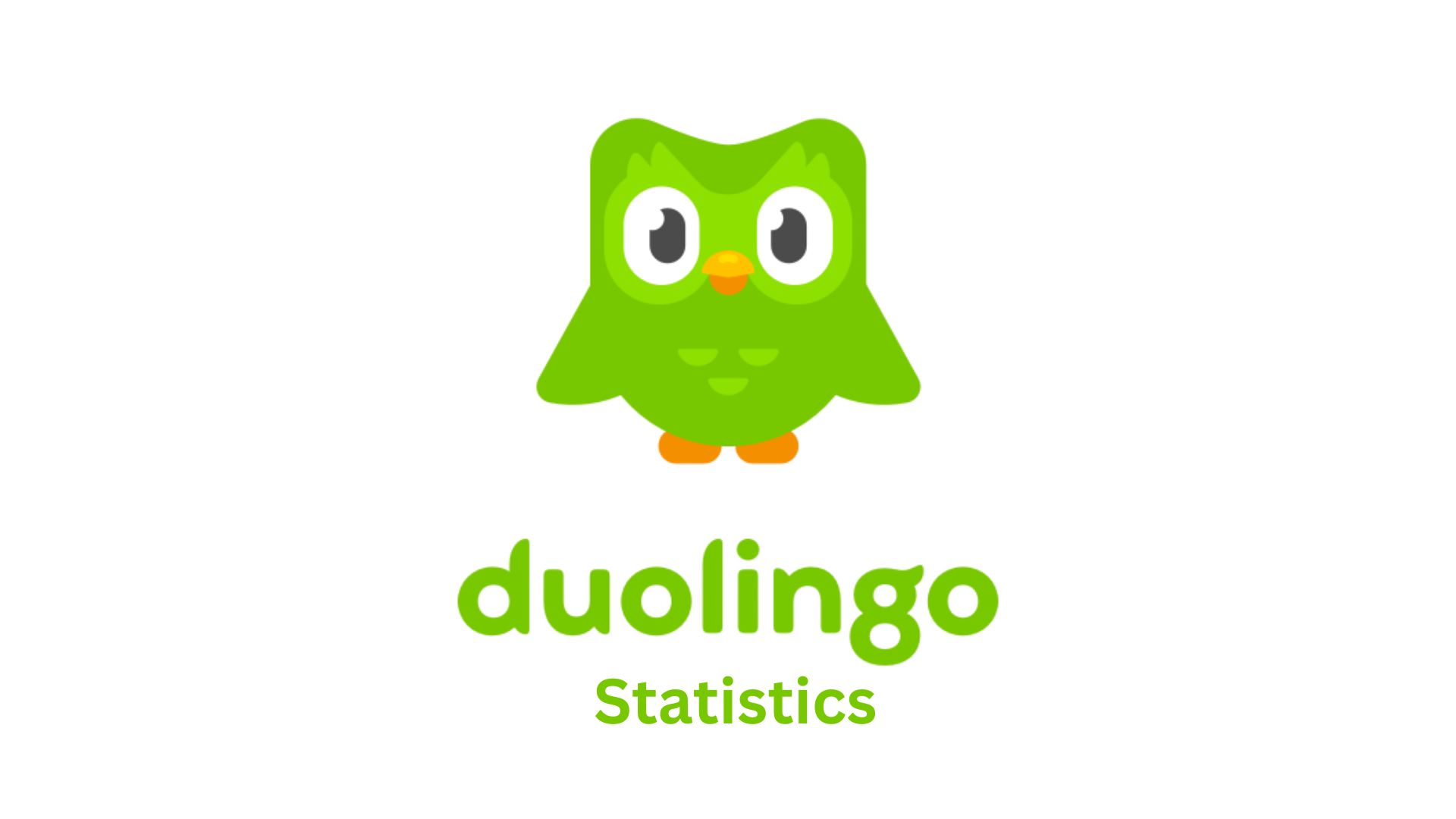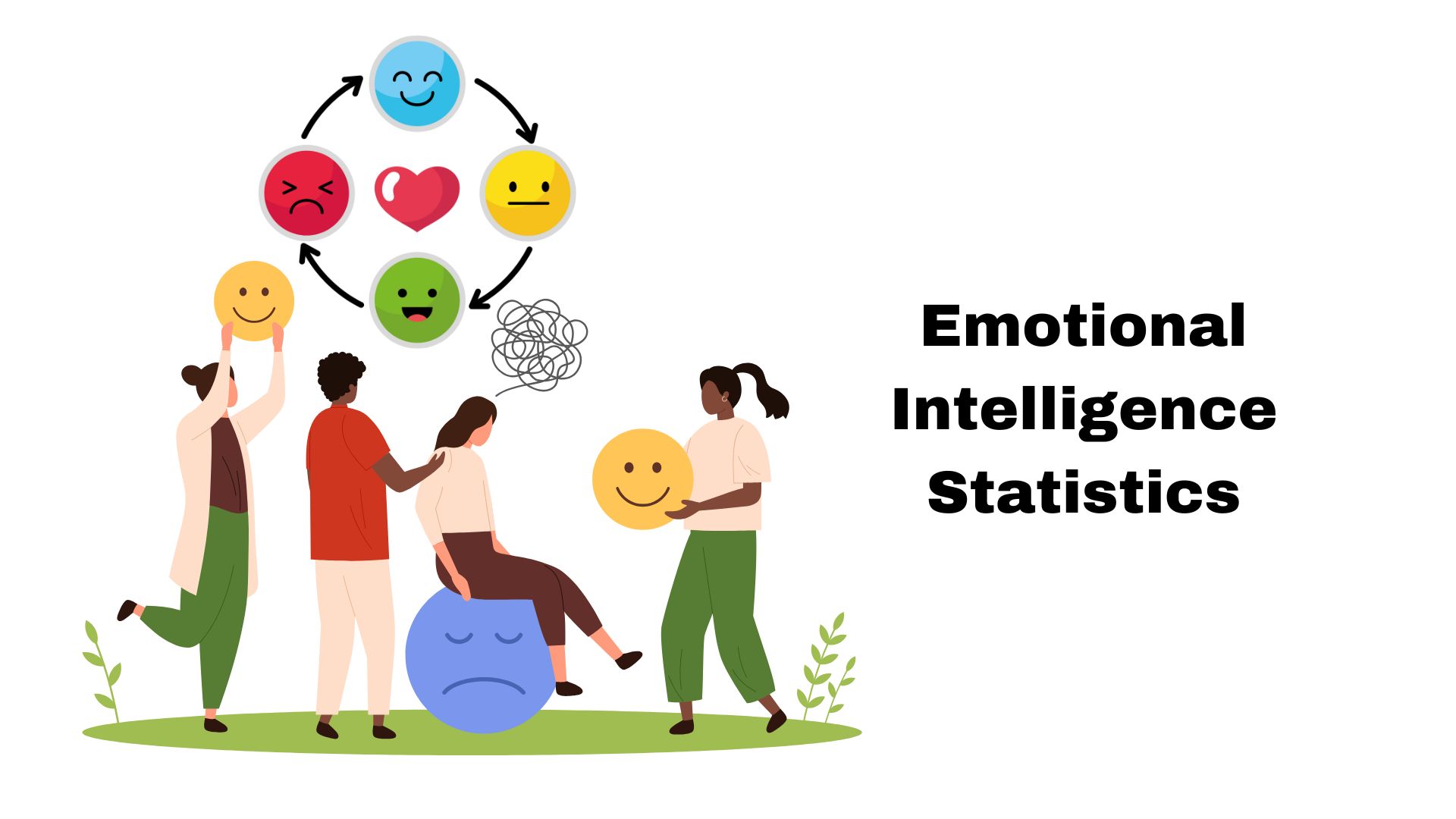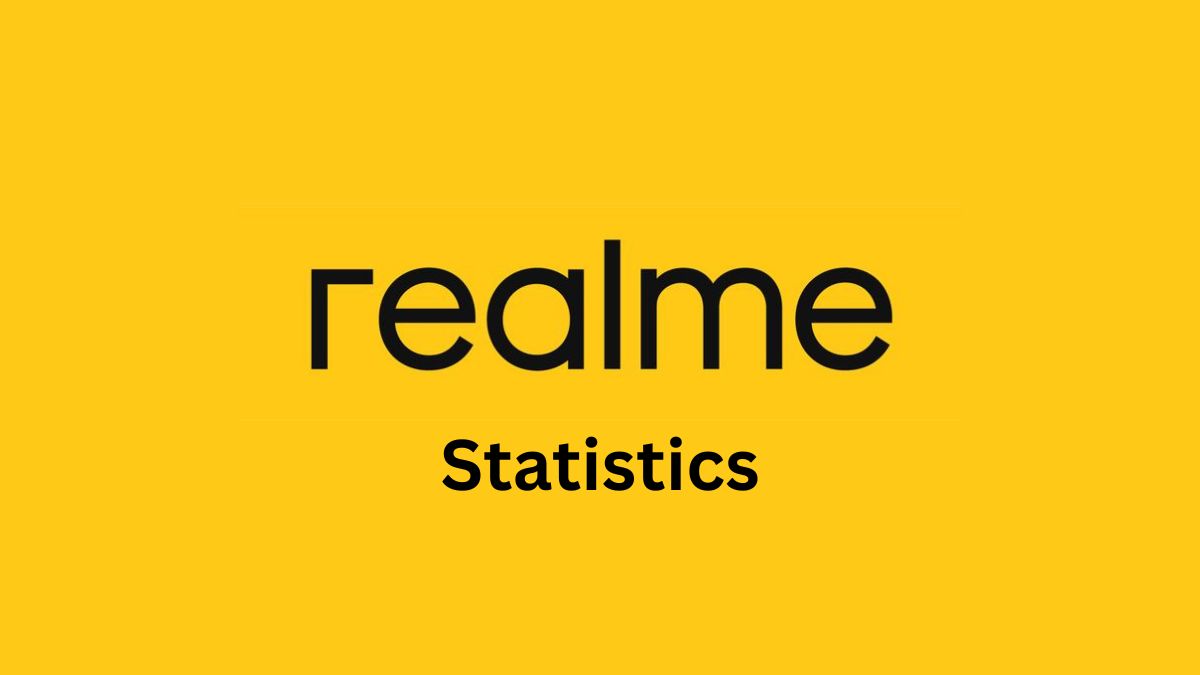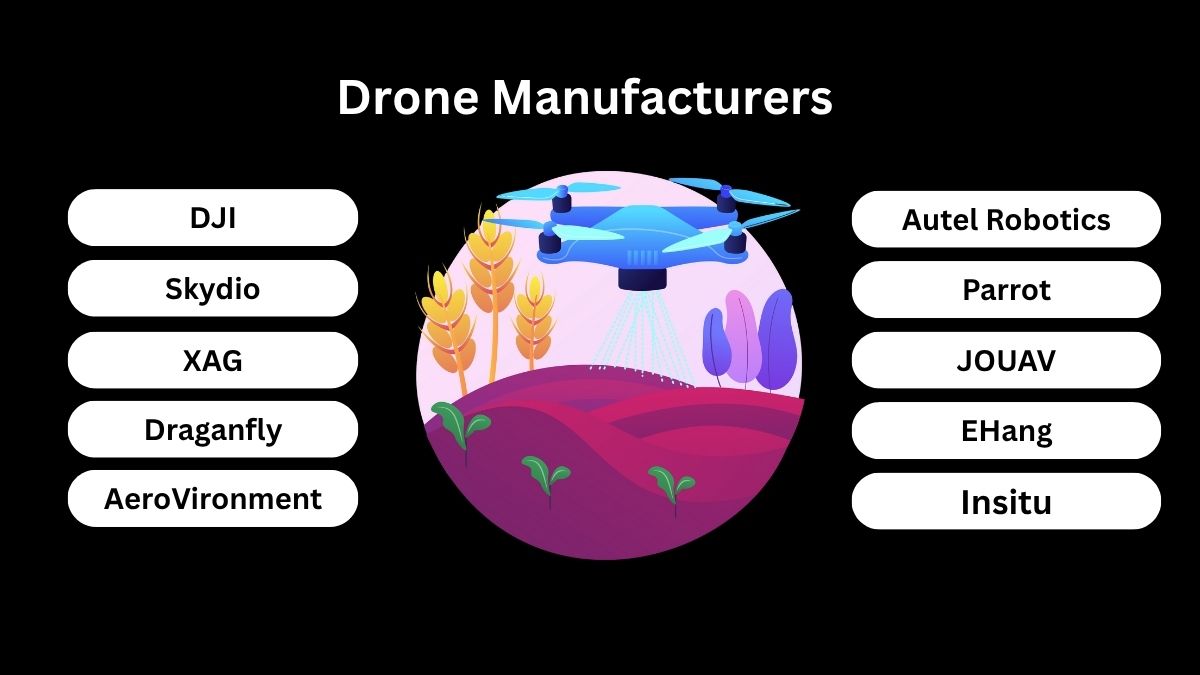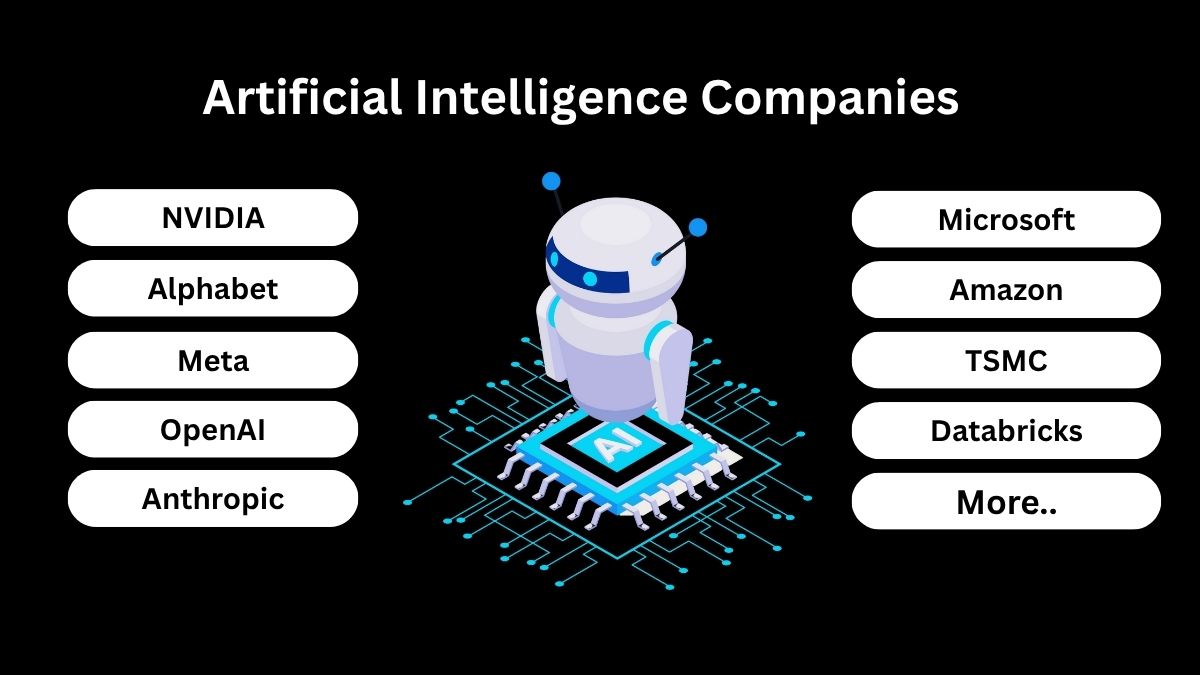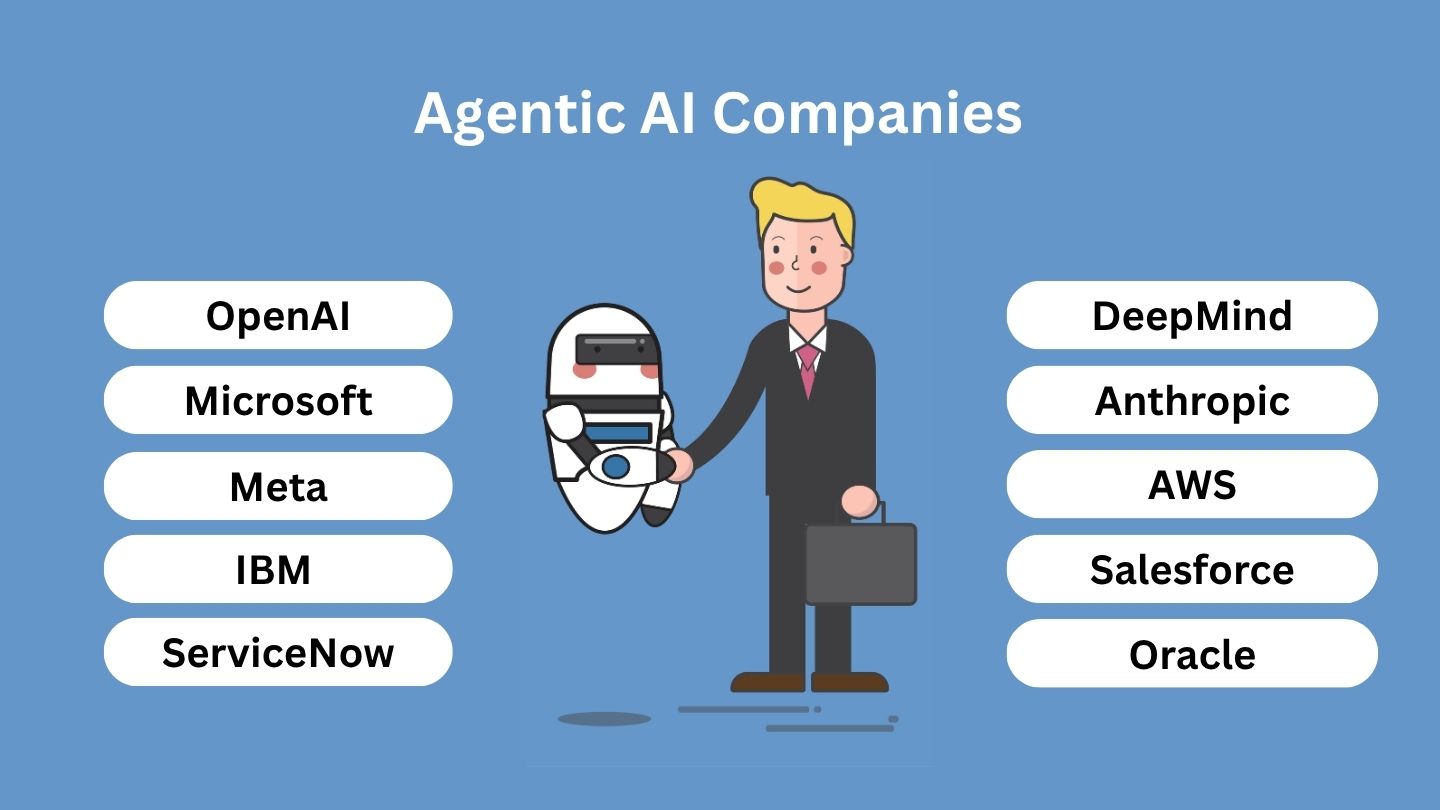Gemini (Google DeepMind) Statistics And Facts (2025)
Updated · May 08, 2025
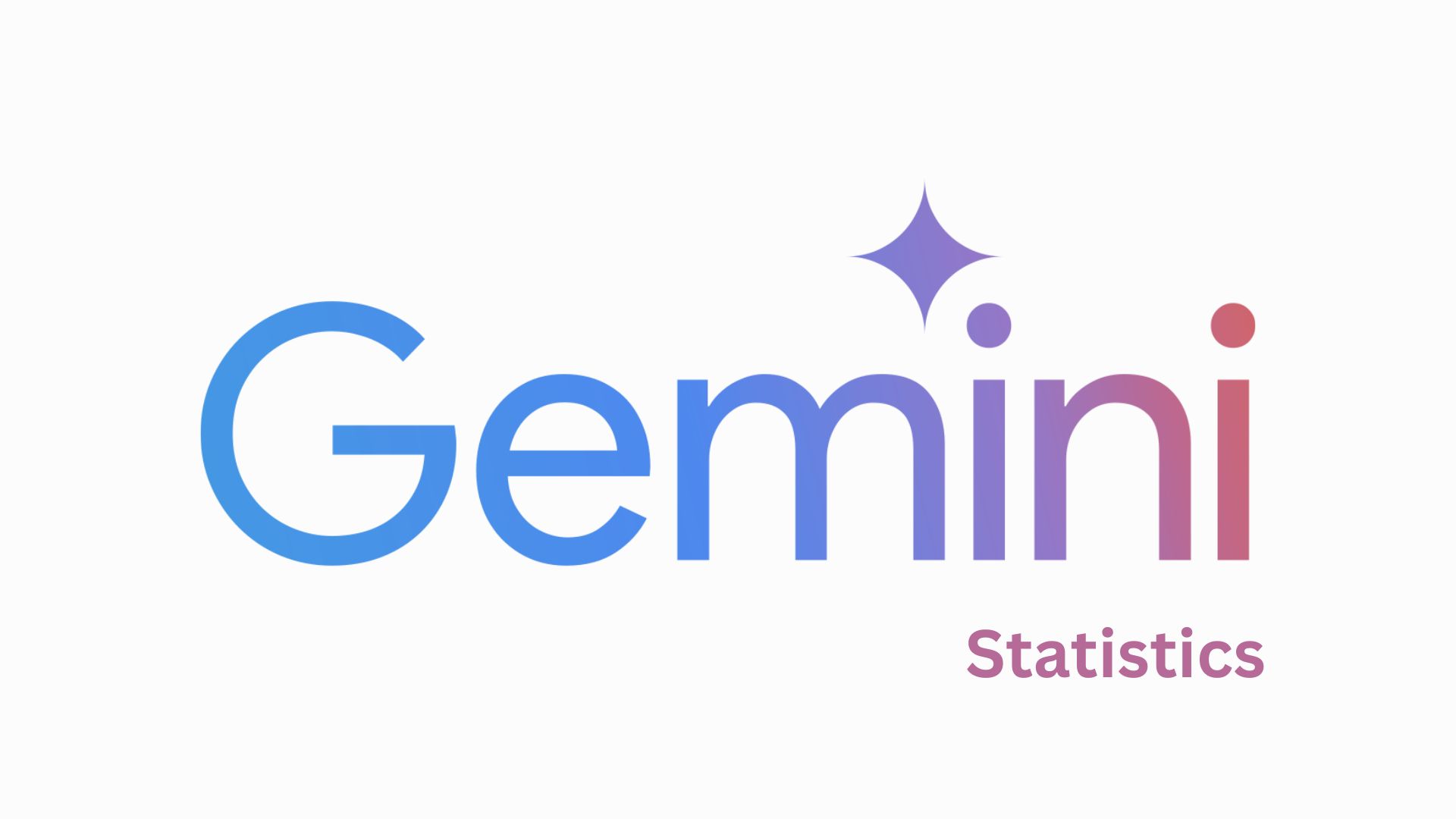
Table of Contents
Introduction
Gemini (Google DeepMind) Statistics: DeepMind Google has a larger variety of more advanced multimodal LLMs to process and generate human-like text, images, and code. Following its December 2023 inauguration and with rapid developments, Gemini aims to rival the most superior AI models, namely OpenAI’s GPT-4 and Meta’s LLaMA. This article provides an exhaustive Gemini (Google DeepMind) statistics, technical abilities, user engagement, and visitors for 2025.
Editor’s Choice
- Gemini registered overall visits standing at 284.1 million in the month of February, along with 67.29 million unique visitors, exhibiting substantial growth in desktop-based traffic.
- User engagement improved, especially on desktop, with bounce rates dropping from 35.34% in December 2024 to 27.1% in February 2025, and average pages per visit rising.
- According to Gemini (Google DeepMind) statistics, direct traffic was at 208.8 million in February 2025, while display ad traffic increased by 136% since December 2024.
- Gemini 1.5 Flash is the cheapest at US$0.07 per million input tokens and US$0.3 per million output tokens, and it is way cheaper than GPT-4o and Claude 3.7 Sonnet.
- The number of active users went up from 23 million in February 2024 to 42 million in October 2024.
- Downloads per month skyrocketed from 0.3 million in April 2024 to 21.4 million in December 2024, so much so that it seemed the interest was increasing exponentially.
- Bard, a LaMDA-based model, was trained on 1.56 trillion words with 137 billion parameters, using 750 GB of storage only.
- Gemini 1.5 Pro offers up to 2 million context window tokens, the longest among large models.
- Artificial Intelligence Index rated Gemini 2.0 Flash 48, ahead of GPT-4o and Llama 3.3.
- Gemini 2.0 Flash leads in speed with 263 tokens/second, followed by Gemini 2.5 Pro at 194.
- Gemini 2.5 Pro has gone past GPT-4.5 in major benchmarks relating to reasoning, science, math, and code editing.
- The IPO of Google came into the market in August 2004 at US$85/share, managed to raise US$1.7 billion, and valued the Company at US$23.1 billion.
- In January 2025, the share price of Google was approximately US$200/share, and it had a market cap of US$2.51 trillion.
- The month of September 2024 saw the announcement by Sundar of an investment of US$120 million into the Global AI Opportunity Fund, which aimed to further the cause of AI education globally.
General Facts
- After being rebranded from Google’s earlier AI tool, Bard, the Gemini entered the generative AI market in early 2024.
- Created by Google, Gemini aims to rival top models like ChatGPT, especially excelling in reasoning abilities.
- The two variants of Gemini are a mobile edition and a browser edition, with each edition having different capabilities.
- Gemini Ultra is an improved Bard edition. Bard was initially launched in March 2023 but met with poor reviews for its inaccurate and staged responses.
- Though it had its early flaws, Bard was among the first generative AI tools in the market; as competition rose, it is now called Gemini and has undergone various improvements.
- Gemini Ultra can perform several operations, from writing code to solving math problems, text generation, and image creation. All of these activities are deep learning-based.
- In May 2024, Google announced Gemini integration into Google Workspace tools such as Gmail, Calendar, and Docs for support in writing and organising activities.
- Gemini was to be integrated with Google Search to offer assistance in various tasks, including itinerary creation and providing faster and simpler answers.
- In-vitro tests reveal that Gemini Ultra is near the top of the hierarchy as it bests GPT-4, among others, including Grok-1 and Claude 2, particularly in intricate fields such as health, engineering, and design.
- Being a strong player among the other models, Google took advantage of the comeback. This came after OpenAI’s and Microsoft-backed rival gained ground in the past few years.
Gemini Monthly Visits
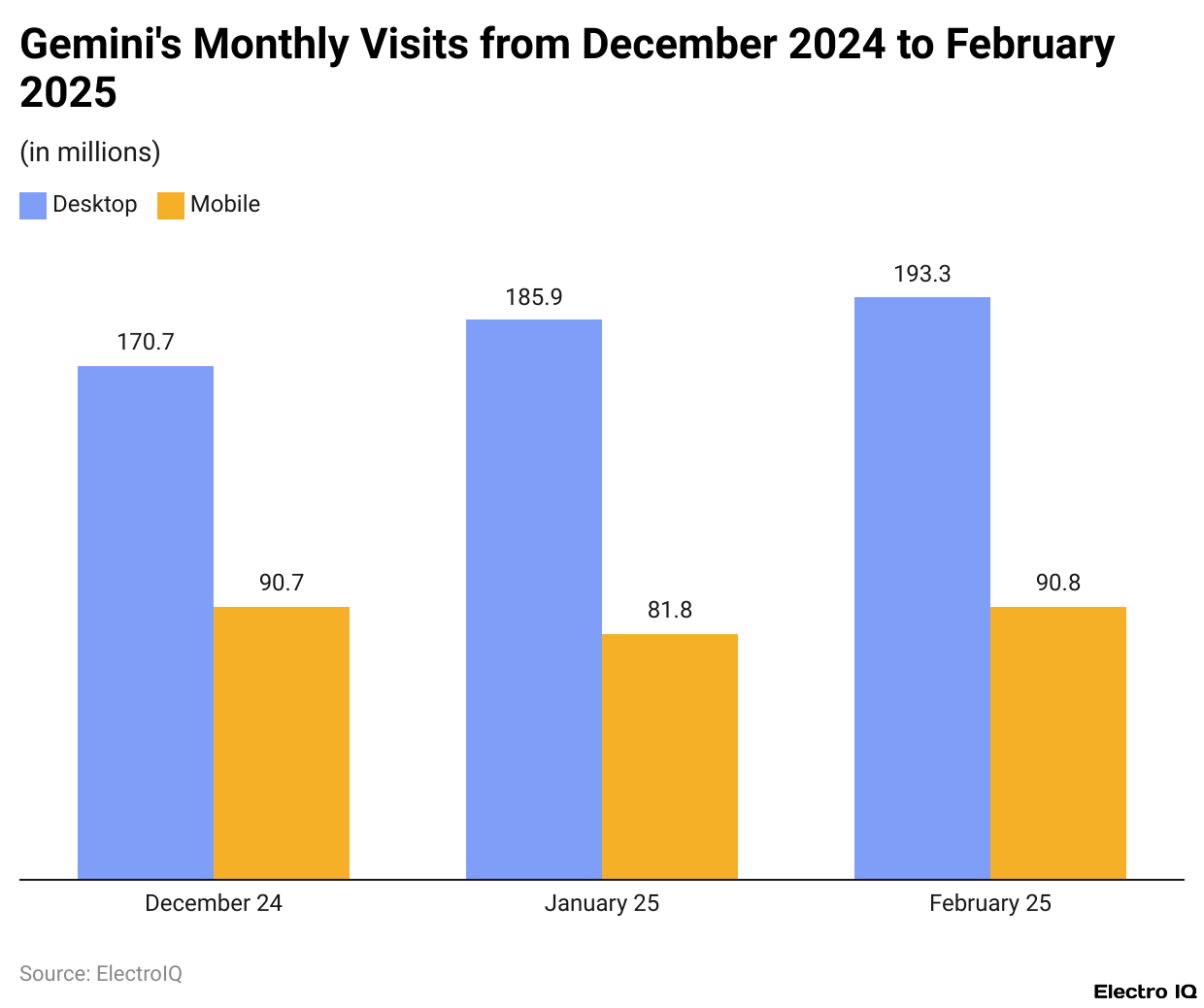
(Reference: doit.software)
- Gemini (Google DeepMind) statistics show that in February 2025, the Google Gemini saw 284.14 million, the peak monthly traffic, with an increase of 6.14% compared to January 2025.
- Out of the total August visits, 193.37 million were desktop visits, whereas 90.83 million were mobile visits.
- Despite the overall increase, the mobile traffic is on a downward trajectory. In January 2025, 81.72 million visits came from mobile devices, down 9.88% from the 90.69 million mobile visits in December 2024.
Gemini Unique Monthly Visitors
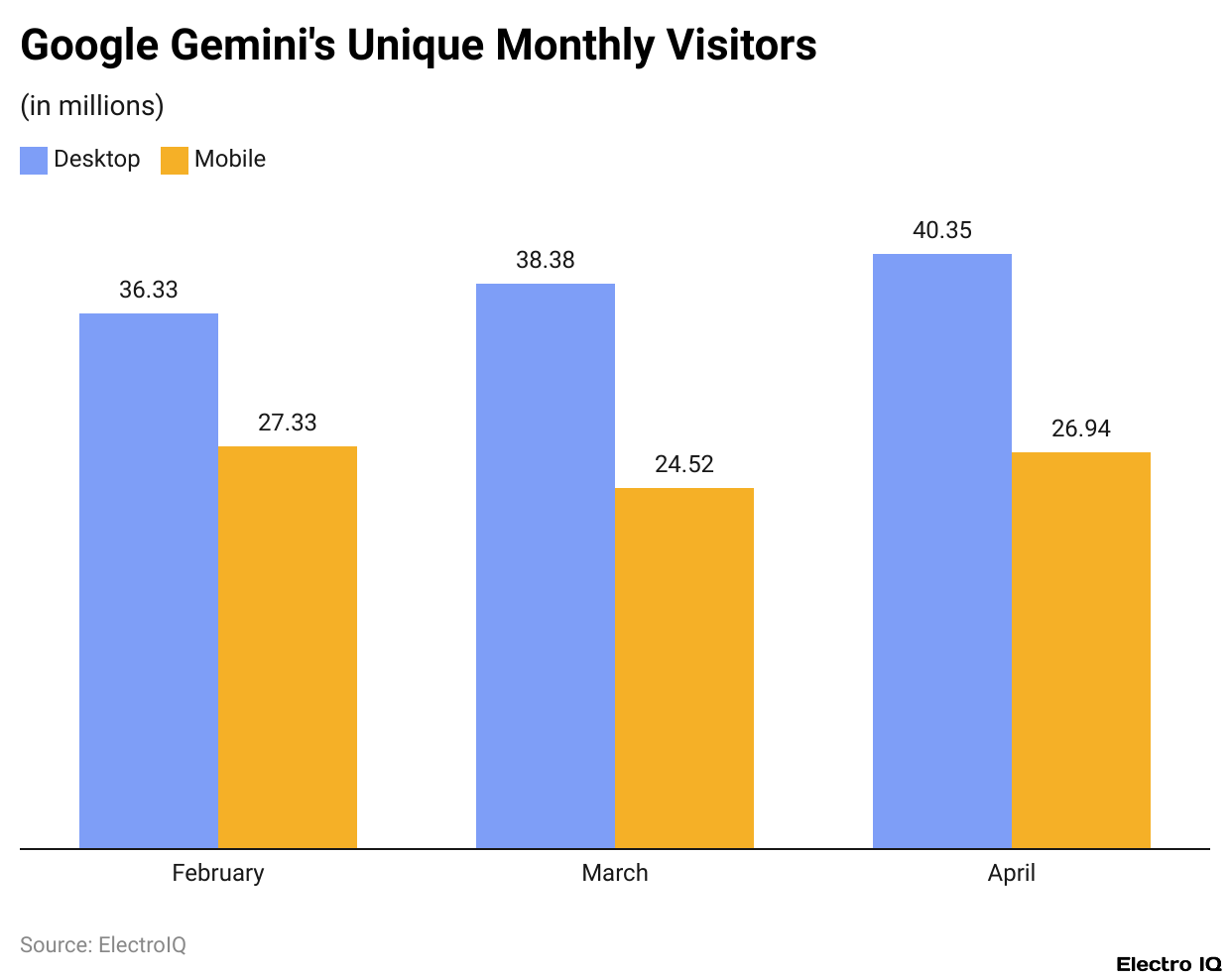
(Reference: doit.software)
- Gemini (Google DeepMind) statistics indicate that in February 2025, Google had 67.29 million unique visitors on the Gemini platform, a slight increase from 62.91 million visitors in January.
- Visitors remained at 67.29 million in April.
- For desktops, unique visitors grew from 36.33 million in December 2024 to 40.35 million by February 2025.
- Mobile unique visitors, meanwhile, enjoyed a small drop, waning from 27.33 million to 26.94 million.
User Engagement And Bounce Rate Trends For Google Gemini
- The user engagement and bounce rates of Google Gemini have remained almost constant in recent times, slightly wavering over desktop and mobile.
- From the bounce rate perspective, an improvement in desktop performance can be witnessed.
- Gemini (Google DeepMind) statistics reflects around 35.34% was the bounce rate for the desktop at the end of December 2024, which dropped by 13.33% to 30.63% in January 2025, then slashed by 11.52% more to 27.1% in February 2025, standing testimony for gaining interest among desktop users.
- While talking about liquids, minor changes were observed in the bounce rate on mobile.
- It increased by 2.29% from 44.04% in December 2024 to 45.05% in January 2025 and then witnessed a fall of 0.6% down to 44.78% in February, indicating quite stable levels of engagement on the mobile front.
- Average pages viewed per visit can be cited as another important engagement indicator. This parameter was increasing better day by day for desktop users: 2.77 pages in December 2024, then 2.8 pages in January 2025 (+1.35%) and 2.92 pages in February 2025 (+4.04%).
- Mobile users accounted for an even stronger engagement level. In December 2024, the average number of pages seen per visit was 3.94.
- This number slightly dipped to 3.9 in January (-0.99%) but increased again in February 2025, going to 4.06 pages, indicating user interaction per session was on an upward trend.
- Indeed, such are positive Gemini (Google DeepMind) statistics for the AVG user engagement trend, especially for the desktop version of Google Gemini, with improving bounce rates and increasing page views per visit.
Gemini Marketing Channels
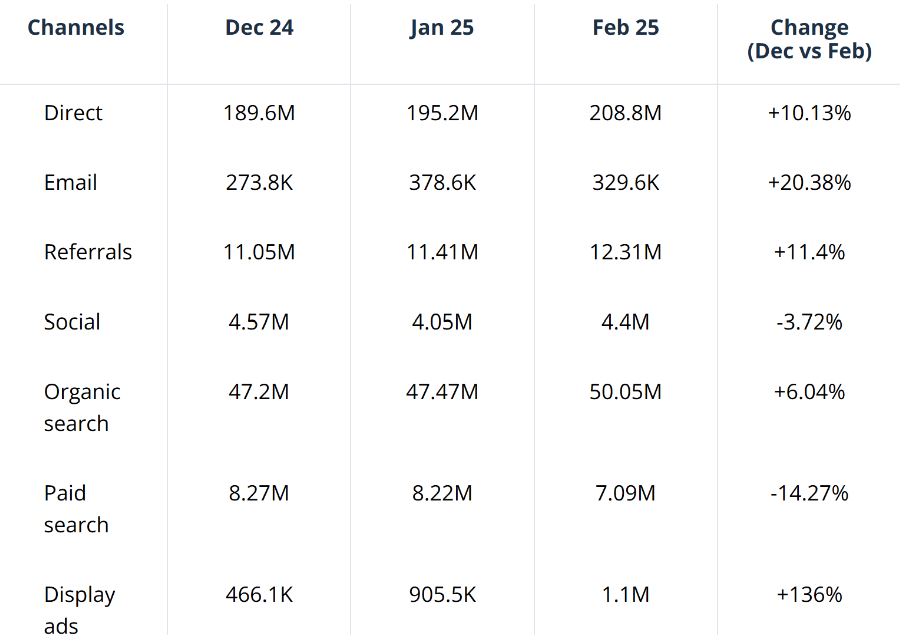
(Source: doit.software)
- The Gemini (Google DeepMind) statistics data regarding direct traffic to Gemini hit its peak in February 2025, with 208.8 million visits, showing a 10.13% increase from 189.6 million visits in December 2024.
- The email traffic also showed a considerable increase between the months, growing by a whopping 20.38%, from 273.8K in December to 329.6K in February, despite a peak of 378.6K in January.
- Referral traffic increased by 11.4%, from 11.05 million in December to 12.31 million in February. Organic search witnessed a steady rise of 6.04%, from 47.2 million to 50.05 million.
- Meanwhile, social media noticed a drop of 3.72%, going down from 4.57 million in December to 4.4 million in February.
- Paid search suffered a significant drop of 14.27%, thinning out from 8.27 million in December to 7.09 million in February. Display carried dramatic growth, growing by 136%, from 466.1K to 1.1 million during the same period.
Gemini Cost
- Gemini (Google DeepMind) statistics reveal that the Gemini 1.5 Flash holds the distinction of being one of the cheapest advanced AI models, charging US$0.07 per million input tokens and US$0.3 per million output tokens.
- The input tokens refer to the data sent to the model, while the output tokens refer to the generated content in the model’s entire response.
- With such pricing, Gemini 1.5 Flash remained very inexpensive when compared with the costlier models.
- In comparison, the Premik Gemini 1.5 rates US$1.25 per million input tokens, yet US$5 per million output tokens.
- Then gets pricier with Gigant-GPT-4o ratings of US$2.5 for input and US$10 for output tokens.
- Claude 3.7 Sonnet ranks the highest in pricing, charging US$3 per million input tokens and US$15 per million output tokens.
Gemini Active Users
- In 2024, Google Gemini sustained its steady growth in the number of active users, measured in millions.
- In February 2024, the platform had 23 million active users. Afterwards, the number grew… somehow much more.
- By June 2024, 37 million users were under this platform, a huge plus of 14 million users in barely four months.
- The trend continued over the year till, in October 2024, there were 42 million active users on Gemini.
- This means over eight months, a good 19 million users were added, indicating solid and very consistent growth in user adoption and engagement as the platform matured and expanded its capabilities.
Gemini Monthly Downloads
| Month |
Downloads (mm)
|
| April | 0.3 |
| May | 3.1 |
| June | 5.4 |
| July | 6.8 |
| August | 17 |
| September | 12.6 |
| October | 11.8 |
| November | 20.9 |
| December | 21.4 |
(Source: businessofapps.com)
- Gemini (Google DeepMind) statistics indicate that in 2024, monthly download figures for Google Gemini went on to show rapid growth with rising user interest and adoption.
- The download figures, however, were less enthusiastic in April, standing at just 0.3 million. Then, in May, there was a surge to 3.1 million downloads.
- After that, downloads appreciated further to 5.4 million in June and 6.8 million in July.
- The major jump occurred in August, when downloads rose to 17 million—more than twice the figure from the prior month.
- Subsequently, there were modest drops to 12.6 million in September and 11.8 million in October.
- Yet the trend reversed in November with 20.9 million downloads and reached a season top in December with 21.4 million downloads.
- This pattern denotes a prevailing strength and growth of popularity for the Gemini platform during the year.
Gemini Tech Statistics
- Google Gemini has stood well in comparison with other top AI language models and, more importantly, has a technical edge over them.
- The first model, Bard, was in essence a further trained LaMDA, trained on the Infinite dataset comprising 1.56 trillion words and 137 billion parameters.
- Despite this great scale, however, the dataset needed only 750 GB of storage: content-wise, the dataset consists of 12.5% C4-based data, 12.5% code documents, 6.5% English web documents, and 6.5% non-English web content.
- According to Gemini (Google DeepMind) statistics, Gemini 1.5 Pro offers a special context window of up to two million tokens—the longest ever across large-scale foundation models.
- Both Gemini 1.5 Pro and 1.5 Flash have a default limit of one million tokens, letting them manage retrieval tasks for long contexts with precision in varied formats like documents, code, audio, and video.
- Enterprise users are eligible to sign up for a two-million-token extended window. Gemini 2.0 Flash scored a 48 on the Artificial Intelligence Index for intelligence and reasoning, outdoing both GPT-4o and Llama 3.3 which scored 41.
- Top scores went to o3-mini and Grok 3 Reasoning Beta, with both scoring 66 across domains like reasoning, math, and coding.
- In executor speed, Gemini 2.0 Flash stands in first position with 263 output tokens per second, followed by Gemini 2.5 Pro at 194 tokens per second, Nova Pro at 129, and GPT-4o at 125 tokens per second.
- Further down the leaderboard are Claude 3.7 Sonnet at 77 and DeepSeek V3 at abysmal 33 tokens per second.
- Among all versions of Gemini, Gemini 2.5 Pro turns out to be the best-performing model, outranking even GPT-4.5 on several key benchmark tests.
- In Humanity’s Last Exam (reasoning), Gemini 2.5 Pro recorded 18.8%, whereas GPT-4.5 got 6.4%. It scored 84.0% in science-oriented tests on the GPQA diamond benchmark, against GPT-4.5’s 71.4%.
- For mathematics (AIME 2024), it recorded the highest percentage of 92.0%, far ahead of GPT-4.5’s 36.7%.
- In code editing (Aider Polyglot), Gemini again took the lead: 68.6% against 44.9% for GPT- 4.5.
- It also outperformed in the MMMU visual reasoning with 81.7% and ranked competitively in SimpleQA factuality at 52.9%, with GPT-4.5 still leading by 62.5%.
Gemini IPO And Stock Price
- Google went public on August 19, 2004. During its IPO, its shares were priced at US$85 a piece.
- It was registered under the stock symbol NASDAQ: GOOG and raised US$1.7 billion from the general public, thereby placing its valuation at US$23.1 billion at that time. Since then, the price of Google shares and general value of the company have seen giant growths in valuation.
- Gemini (Google DeepMind) statistics reveal that by January 30, 2025, the price of the share approximately got to US$200, giving the company an exorbitant market capitalization of US$2.51 trillion.
- While raising funds was one motive, Google also used it to make contributions towards international development.
- On September 21, 2024, at the “Summit of the Future” organized by the United Nations, the CEO of Google, Sundar Pichai, announced an investment of US$120 million into the Global AI Opportunity Fund.
- The fund works toward enabling AI education by collaborating with nonprofit organizations and NGOs to provide training in local languages, thereby making knowledge about AI accessible in different parts of the world.
Conclusion
Gemini (Google DeepMind) statistics reveal that there has been a really quick rise of Google Gemini as a big player in the AI world. It runs AI operations fairly well, and its potential is evident from its continued user base growth and further adoption in the enterprise world.
It rarely has many users compared to other services like ChatGPT and Meta AI, yet being integrated into Google’s resources ensures that it has a guaranteed way for sustained growth. The technical viability and future-proofing of multimodality place Gemini at the centerpiece of AI evolution.
FAQ.
Google Gemini is a multimodal language generation model developed by Google DeepMind and first launched in December 2023. It competes with the front-line models of OpenAI with its GPT-4 and Anthropic’s Claude 3.7 Sonnet. Gemini models, especially Gemini 2.5 Pro and 2.0 Flash, far outdo the competitors in reasoning, science, math, code editing, and speed, while being more cost-efficient for developers.
In February 2025, in total monthly visits, Gemini was able to amass 284.1 million; out of those, 67.29 million were unique visitors. Active user count rose from 23 million in February 2024 to 42 million in October 2024. On the other hand, the downloads for the app grew from 0.3 million in April 2024 to 21.4 million in December 2024, suggesting the fast pace of adoption and the growing interest.
Gemini 1.5 Flash is the most budget-friendly model. At US$0.07 for a million input tokens and US$0.30 for output tokens, it is extremely cheaper than alternatives such as GPT-4o or Claude 3.7 Sonnet. Gemini 1.5 Pro has the advantage of employing a humongous context window of 2 million tokens, goodness for content generation that’s complex and long-form, and for retaining strong benchmarks in reasoning and speed.
User engagement has skyrocketed, especially on desktop. Bounce rates have diminished from 35.34% in December 2024 to 27.1% in February 2025. The pages viewed per visit have increased from 2.77 to 2.92 on desktop, and mobile engagement remains steady at an average of 4.06 pages per session in February 2025. These are indeed promising trends pointing toward increased and sustained user interaction.
Gemini has a remarkably extensive range of technical strengths, including, among others, the greatest possible context window (up to 2 million tokens), the highest benchmark scores in reasoning, science, and math, and the fastest token generation rate (263 tokens/sec in Gemini 2.0 Flash). In addition, its foundation model was trained over 1.56 trillion words while occupying a mere 750 GB of storage space-an indication that efficiency and scale were top priorities.

Joseph D'Souza founded ElectroIQ in 2010 as a personal project to share his insights and experiences with tech gadgets. Over time, it has grown into a well-regarded tech blog, known for its in-depth technology trends, smartphone reviews and app-related statistics.



